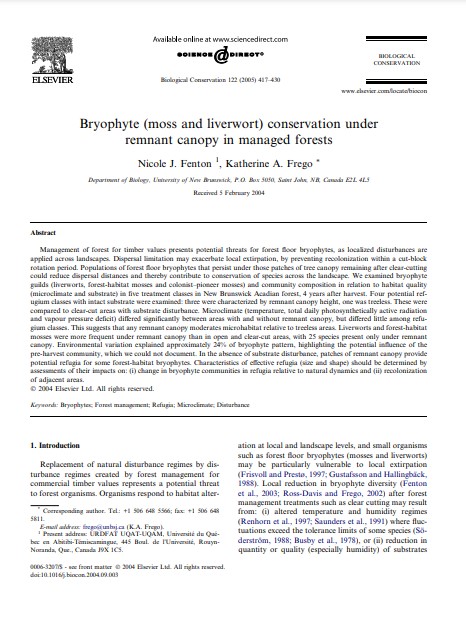Bryophyte (moss and liverwort) conservation under remnant canopy in managed forests
Bosque Modelo:
Fundy
Temática:
Conservación
Tipo de documento:
Artículo científico
Resumen
Management of forest for timber values presents potential threats for forest floor bryophytes, as localized disturbances are applied across landscapes. Dispersal limitation may exacerbate local extirpation, by preventing recolonization within a cut-block rotation period. Populations of forest floor bryophytes that persist under those patches of tree canopy remaining after clear-cutting could reduce dispersal distances and thereby contribute to conservation of species across the landscape. We examined bryophyte guilds (liverworts, forest-habitat mosses and colonist–pioneer mosses) and community composition in relation to habitat quality (microclimate and substrate) in five treatment classes in New Brunswick Acadian forest, 4 years after harvest. Four potential refugium classes with intact substrate were examined: three were characterized by remnant canopy height, one was treeless. These were compared to clear-cut areas with substrate disturbance. Microclimate (temperature, total daily photosynthetically active radiation and vapour pressure deficit) differed significantly between areas with and without remnant canopy, but differed little among refugium classes. This suggests that any remnant canopy moderates microhabitat relative to treeless areas. Liverworts and forest-habitat mosses were more frequent under remnant canopy than in open and clear-cut areas, with 25 species present only under remnant canopy. Environmental variation explained approximately 24% of bryophyte pattern, highlighting the potential influence of the pre-harvest community, which we could not document. In the absence of substrate disturbance, patches of remnant canopy provide potential refugia for some forest-habitat bryophytes. Characteristics of effective refugia (size and shape) should be determined by assessments of their impacts on: (i) change in bryophyte communities in refugia relative to natural dynamics and (ii) recolonization of adjacent areas.
Información Bibliográfica
Autor:
Fenton, NJ and KA Frego.
Revista:
Biological Conservation
Año:
2005
N°:
-
País :
Canadá
Páginas:
417 - 430
Volumen:
122
Idioma:
Ingles
Palabras claves
Bryophytes; Forest management; Refugia; Microclimate; Disturbance





